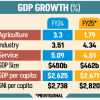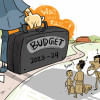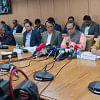GDP growth slows to 6.03% in FY23

The economy is estimated to have expanded at a slower-than-expected pace in 2022-23, said the Bangladesh Bureau of Statistics (BBS) yesterday, a figure that analysts describe as good in view of elevated inflation, slowing exports and remittances and the ongoing pressure on the country's foreign exchange reserves.
The gross domestic product (GDP) grew by 6.03 per cent in the fiscal year, ending in June, said the national statistical agency based on its provisional estimate.
The economy expanded by 7.1 per cent in 2021-22 but the buoyancy began to slow down following the Russia's invasion of Ukraine in February 2022.
Yesterday, Prof Shamsul Alam, state minister for planning, shared the GDP growth estimate of the BBS after the meeting of the National Economic Council. He gave no details.
The estimate of the BBS is higher than the projection made by the international agencies such as the World Bank, the International Monetary Fund and the Asian Development Bank.
Among the three, the IMF projected the highest growth at 5.5 per cent of GDP for FY23.
The BBS projection is based on the performance of the various indicators of the economy in the first half of FY23 and is lower than the government's goal of 6.5 per cent.
The economic growth target was revised downward twice since the beginning of the fiscal year in July owing to the continuing stress in the economy.
Zahid Hussain, a former lead economist of the World Bank's Dhaka office, told The Daily Star that the downward estimate has aligned the growth rate with reality.
"Every indicator related to the GDP growth has been weak. So, the government has had to revise the target downwards."
"Imports fell, remittance growth has remained flat while private credit growth has slowed. Only the export growth was in a good shape initially and it has slowed down of late."
In April, remittance declined 16.27 per cent year-on-year to $1.68 billion. Overall, money transferred by migrant workers and non-resident Bangladeshis living abroad grew 2.36 per cent to $17.71 billion in July-April.
Export earnings dipped 16 per cent year-on-year in April, with overall receipts growing by 5.38 per cent to $45.67 billion in the 10-month period.
Import bills dropped 12.33 per cent to $53.93 billion in the first three quarters.
Hussain, citing Bangladesh Bank data, said credit to the private sector slowed to 12.03 per cent in March from a year ago.
"The manufacturing sector is suffering from the dollar shortage and load-shedding while the structural problems of the economy have persisted for years."
He said if the 6 per cent growth rate is achieved at the end of the year, it would be excellent.
"Only a small number of countries are estimated to grow at more than 6 per cent in the current situation."
Prof Mustafizur Rahman, a distinguished fellow at the Centre for Policy Dialogue, said, "It is good to see that the government has lowered the projection as we need to bring macroeconomic stability first."
MK Mujeri, a former director-general of the Bangladesh Institute of Development Studies, termed the projection optimistic, considering the present macroeconomic situation, both local and global.
"If the growth rate is achieved, it would be good for the country."
The former central bank chief economist said the global economy is still facing uncertainty and the macroeconomic situation in Bangladesh has remained volatile.
"This volatility has taken a toll on the real economy."
CPD's Rahman said in order to restore macroeconomic stability, interest rates have to be made market-based. But it may impact investments.
He said expenditure needs to be cut to reduce fiscal deficit.
"If expenses are cut, the GDP growth rate may drop in the upcoming fiscal year. But the fascination over growth should be checked and macroeconomic stability should be emphasised."

 For all latest news, follow The Daily Star's Google News channel.
For all latest news, follow The Daily Star's Google News channel. 








Comments